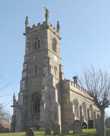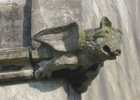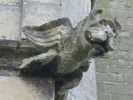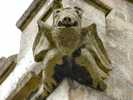 Bothamsall Bothamsall
Our Lady and St Peter
Stonework
Three contemporary references from the 1844-1851 period comment on the stone
used in the new church. The 4th Duke of Newcastle speaks of local stone he
will use, a Nottinghamshire directory claims it was principally stone removed
from Worksop Manor on its partial demolition and the Rev Fiennes-Clinton
observed that it was rebuilt using much of the old material.
The church sits on Triassic rocks of the lower part of the Mercia Mudstone
Group. However it is built principally of Permian magnesian limestone (Cadeby
Formation).
Therefore the best ashlar and dressed limestone throughout probably was recycled
from Worksop Manor as this is the principal stone used in the Worksop area.
The blocks used on the upper tower and parapets generally look like “best
quality” pale coloured magnesian limestone. The moulded and carved work
is of the same stone, where not repaired.
Interspersed on a smaller scale is a much paler grey weathering local skerry
sandstone – the most likely stone to be from the older building, if any
is.
The chancel wall is of a third type being local Triassic sandstone from the
Waterstone-Green Beds to the north of the church. This is a fine grained greenish
grey. Quite possibly this would be from the fine bed of stone discovered at
the time of the 1844-5 build as the Duke records. It is located around the
brickyard the Duke opened in the area to the north of the church. (Its opening
is referred to in the Duke’s diary entry of 9th August 1844. Brick is,
surprisingly, in evidence at the ground level of the tower and may have been
a part of the foundations as well as stone.) A geological survey source of
1910 alludes to the Waterstone-Green Beds and evidence of its use in earlier
days “in excavations around some of the buildings in Bothamsall village.” It
should be pointed out, however, that there was apparently a rebuild of the
chancel walls in 1929-30 but this may have entailed re-use of the existing
stone rather than new stone being introduced.
Inside the church around some windows on the south side of the chancel there
is definite evidence of weathering which leads to the supposition that these
stones have been turned round – evidence of reuse of old stone at the
1844-5 rebuild.
A selection of Grotesque Heads |
 |
 |
 |
 |
On the exterior of the building are several grotesques
which are very weathered and give the church a distinctively ‘gothic’ appearance.
A tribute to the skill of the Victorian carvers - or remnants of the old church?
Although the carved stone is identified as from the Worksop area it should
not be assumed that they must be from the Worksop Manor stone. The old church
would have been built presumably by, or with permission of, the Premonstratensians
monks who had been gifted a quarry at Whitwell early in their time at Welbeck
Abbey which could account for the stone used on some of the carvings here.
Thanks to Dr Graham Lott for his help with this entry.
|